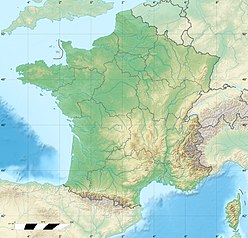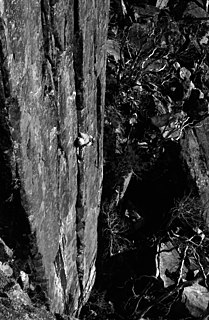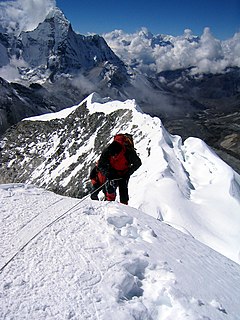
K2, also known as Mount Godwin-Austen or Chhogori, at 8,611 metres (28,251 ft) above sea level, is the second highest mountain in the world, after Mount Everest at 8,848 metres (29,029 ft). It is located on the China–Pakistan border between Baltistan in the Gilgit-Baltistan region of northern Pakistan, and the Taxkorgan Tajik Autonomous County of Xinjiang, China. K2 is the highest point of the Karakoram range and the highest point in both Pakistan and Xinjiang.

Mount Everest, known in Nepali as Sagarmatha (सगरमाथा) and in Tibetan as Chomolungma (ཇོ་མོ་གླང་མ), is Earth's highest mountain above sea level, located in the Mahalangur Himal sub-range of the Himalayas. The international border between Nepal and China runs across its summit point.
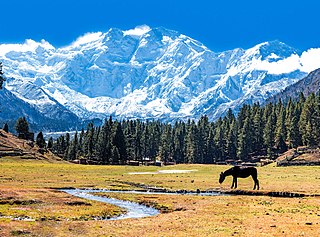
Nanga Parbat, locally known as Diamer, is the ninth highest mountain in the world at 8,126 metres (26,660 ft) above sea level. Located in the Diamer District of Pakistan’s Gilgit Baltistan region, Nanga Parbat is the western anchor of the Himalayas. The name Nanga Parbat is derived from the Sanskrit words nagna and parvata which together mean "Naked Mountain". The mountain is locally known by its Tibetan name Diamer or Deo Mir, meaning "huge mountain".

Shishapangma, also called Gosainthān, is the 14th highest mountain in the world at 8,027 metres (26,335 ft) above sea level. It was the last 8,000 metre peak to be climbed, due to its location entirely within Tibet and the restrictions on visits by foreign travelers to the region imposed by authorities of the Government of China and of the Tibet Autonomous Region.

Gasherbrum II ; surveyed as K4, is the 13th highest mountain in the world at 8,035 metres (26,362 ft) above sea level. It is the third-highest peak of the Gasherbrum massif, and is located in the Karakoram, on the border between Gilgit–Baltistan province, Pakistan, and Xinjiang, China. The mountain was first climbed on July 7, 1956, by an Austrian expedition which included Fritz Moravec, Josef Larch, and Hans Willenpart.

The Eiger is a 3,967-metre (13,015 ft) mountain of the Bernese Alps, overlooking Grindelwald and Lauterbrunnen in the Bernese Oberland of Switzerland, just north of the main watershed and border with Valais. It is the easternmost peak of a ridge crest that extends across the Mönch to the Jungfrau at 4,158 m (13,642 ft), constituting one of the most emblematic sights of the Swiss Alps. While the northern side of the mountain rises more than 3,000 m (10,000 ft) above the two valleys of Grindelwald and Lauterbrunnen, the southern side faces the large glaciers of the Jungfrau-Aletsch area, the most glaciated region in the Alps. The most notable feature of the Eiger is its 1,800-metre-high (5,900 ft) north face of rock and ice, named Eiger-Nordwand, Eigerwand or just Nordwand, which is the biggest north face in the Alps. This huge face towers over the resort of Kleine Scheidegg at its base, on the homonymous pass connecting the two valleys.

Illimani (Aymara) is the highest mountain in the Cordillera Real of western Bolivia. It lies near the cities of El Alto and La Paz at the eastern edge of the Altiplano. It is the second highest peak in Bolivia, after Nevado Sajama, and the eighteenth highest peak in South America. The snow line lies at about 4,570 metres (15,000 ft) above sea level, and glaciers are found on the northern face at 4,983 m (16,350 ft). The mountain has four main peaks; the highest is the south summit, Nevado Illimani, which is a popular ascent for mountain climbers.
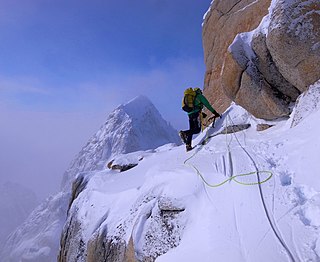
Jess Roskelley was an American mountaineer. On May 21, 2003, at age twenty, he became the youngest American to reach the summit of Mount Everest. He died in an avalanche while climbing Howse Peak in the Canadian Rockies.

The 2008 K2 disaster occurred on 1 August 2008, when 11 mountaineers from international expeditions died on K2, the second-highest mountain on Earth. Three others were seriously injured. The series of deaths, over the course of the Friday ascent and Saturday descent, was the worst single accident in the history of K2 mountaineering. Some of the specific details remain uncertain, with different plausible scenarios having been given about different climbers' timing and actions, when reported later via survivors' eyewitness accounts or via radio communications of climbers who died later in the course of events on K2 that day.
In the history of mountaineering, the world altitude record referred to the highest point on the Earth's surface which had been reached, regardless of whether that point was an actual summit. The world summit record referred to the highest mountain to have been successfully climbed. The terms are most commonly used in relation to the history of mountaineering in the Himalaya and Karakoram ranges, though modern evidence suggests that it was not until the 20th century that mountaineers in the Himalaya exceeded the heights which had been reached in the Andes. The altitude and summit records rose steadily during the early 20th century until 1953, when the ascent of Mount Everest made the concept obsolete.
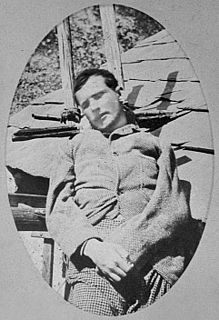
Henri Cordier or Henry Cordier was a French mountaineer. In his short two-year career, he became the first Frenchman to reach the level of the English members of the Alpine Club, in the silver age of alpinism in the second half of the 19th century, which was dominated by the development of mountaineering in the Alps. With some of the Alpine Club's mountain guides and mountaineers, he led significant first ascents in the Mont Blanc massif and in the Dauphiné Alps.

Pierre Gaspard was a French mountain climber, one of the greatest mountain guides in the silver age of alpinism. He made the first ascent of La Meije on 16 August 1877 with his son and Emmanuel Boileau de Castelnau. Their ascent followed the south buttress Arête du Promontoire, which became the "normal route".

David Lama was an Austrian sport climber and mountaineer. He won the European Championship in bouldering in 2007 and the European Championship in lead climbing in 2006. He is known for his first free ascent of the Compressor Route on Cerro Torre. In 2018, in a solo expedition, he was the first to climb Lunag Ri in the Himalayas.
Claude Kogan (1919–1959) was a pioneering French mountaineer who, after climbing a number of peaks in South America, turned to the Himalayas. After notable feats such as the first ascent of Nun, she died in October 1959 while leading a women-only expedition to climb Cho Oyu.

On 18 April 2014, seracs on the western spur of Mount Everest failed, resulting in an ice avalanche that killed sixteen climbing Sherpas in the Khumbu Icefall. This was the same icefall where the 1970 Mount Everest disaster had taken place. Thirteen bodies were recovered within two days, while the remaining three were never recovered due to the great danger of performing such an expedition. Many Sherpas were angered by what they saw as the Nepalese government's meager offer of compensation to victims' families, and threatened a protest or strike. On 22 April, the Sherpas announced they would not work on Everest for the remainder of 2014 as a mark of respect for the victims.
Hayden Kennedy (1990–2017) was an American rock climber and mountaineer who made difficult ascents in North America, Patagonia and in the Himalaya. He committed suicide in 2017 after the sudden death of his partner. He was the son of renowned writer and mountaineer Michael Kennedy and he won the Piolet d'Or for his ascent of The Ogre in 2013.

Hansjörg Auer was an Austrian mountaineer, noted for his free solo climbs, particularly of "The Fish" in the Italian Dolomites. National Geographic described him as "one of the boldest and best climbers in the world." He died in an avalanche while climbing Howse Peak in the Canadian Rockies.





